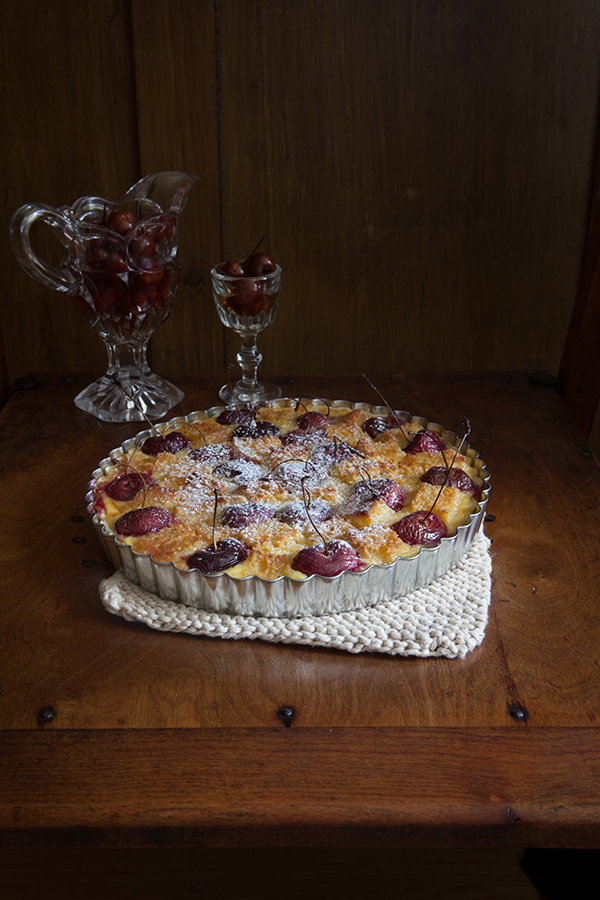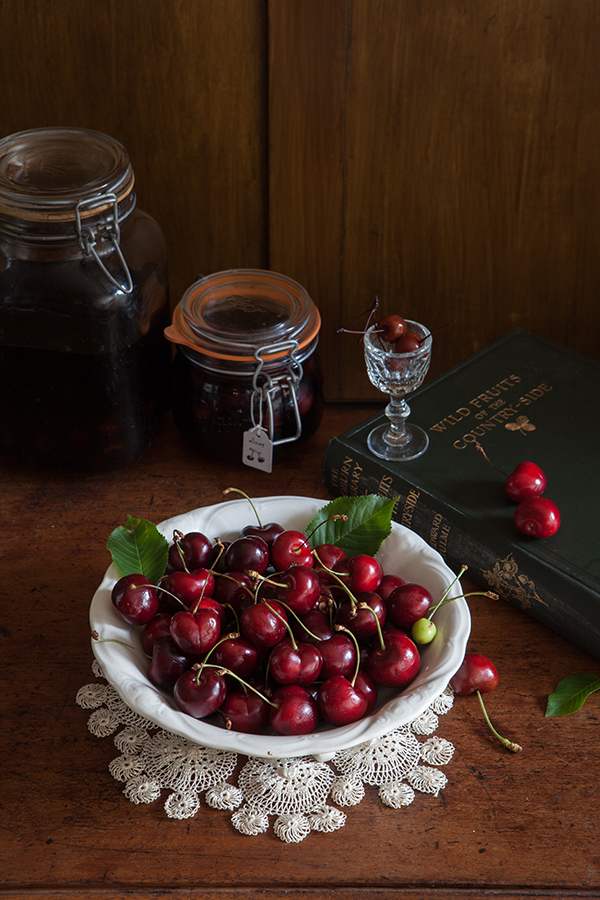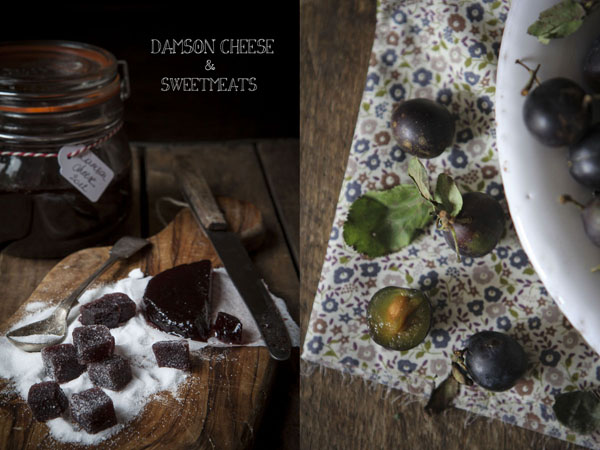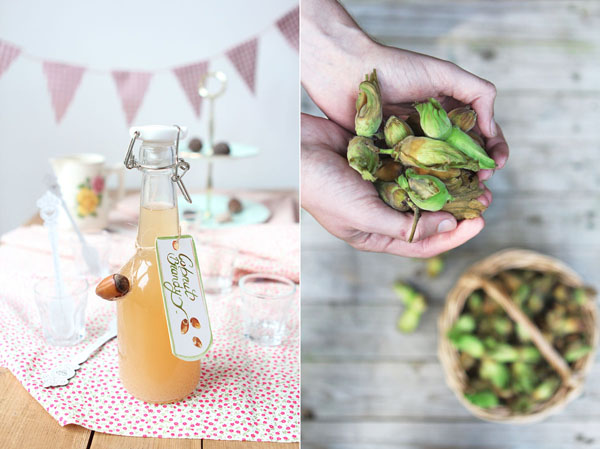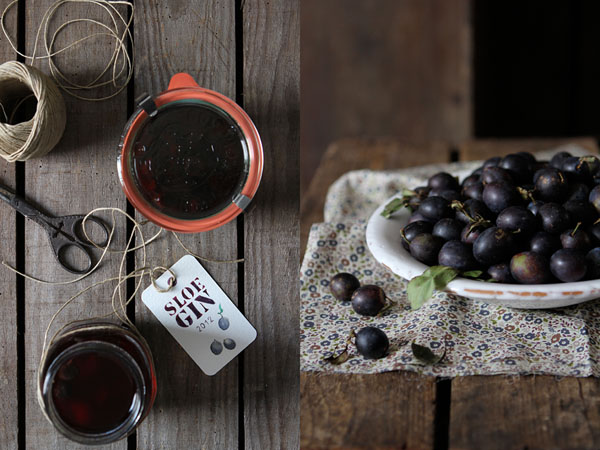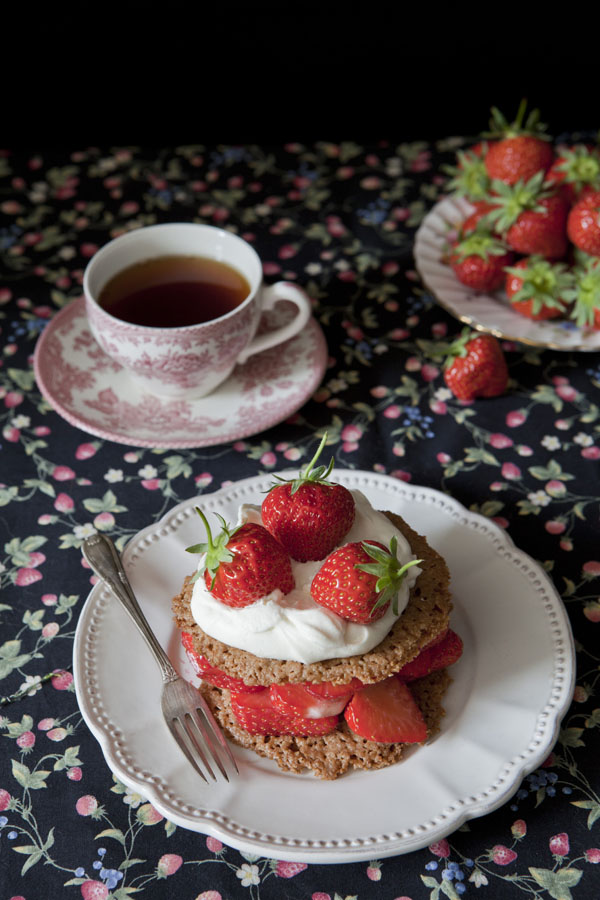 Preparing the cherry brandy or ‘Kriekenborrel’ as we called it in Belgium, is the first step towards Christmas and winter for me. On Christmas eve when I was a child, I was allowed one single drunken cherry in a small dainty glass as a treat. This is how memories are made, and how time and time again when Christmas comes, you need certain flavours to transport you back to the past. Nostalgia and Christmas go hand in hand. It is the one western tradition that is still going strong. People prepare things like this cherry brandy and plum pudding months in advance. The anticipation grows in the jars, and by every spoonful of brandy that is poured over the pudding every week.
Preparing the cherry brandy or ‘Kriekenborrel’ as we called it in Belgium, is the first step towards Christmas and winter for me. On Christmas eve when I was a child, I was allowed one single drunken cherry in a small dainty glass as a treat. This is how memories are made, and how time and time again when Christmas comes, you need certain flavours to transport you back to the past. Nostalgia and Christmas go hand in hand. It is the one western tradition that is still going strong. People prepare things like this cherry brandy and plum pudding months in advance. The anticipation grows in the jars, and by every spoonful of brandy that is poured over the pudding every week.
Preserving fruit in ‘Jenever’ which is almost identical to Gin, has been a custom in our parts for many decades. It was particularly popular in the 1950’s when my grandmother was young. Because my mother grew up with it, it was sentimental to her, which is why she taught me how to make it. I still have the last jar of cherries my mum and I drowned in Eau de Vie in 1998. It is quite special, because the jar holds memories as well as cherries. In my kitchen I have jars from 2006, 2010, 2011 and 2013. Some I give away, ladling the cherries and booze out into smaller jars to decorate with a ribbon and the date. They go to people I know will appreciate my precious preserve. Because I part with memories of making them and hope they will be cherished….
summer
Cherry tart and prostitution
When I was a little girl my parents and I used to travel around Hungary in the summer. I can still remember the warm climate, and the little dresses I wore, many of which I have in a shoe box upstairs. What I also remember is the Bed and Breakfast, back then called ‘Zimmer frei’ in Hungary, which was run by an old couple. The woman looked a lot like my aunt and the man I can’t remember much. Their house was large for Hungary and by a main road, not far from a little restaurant by the river Danube where I always ate a very good omelette for supper.
Our time with the old couple was like staying with your grandparents, sure communication was complicated, they spoke a little German, so did my parents, and I as a four year old strangely enough spoke a good word of German too. They were loving people and love can be shown without the language barrier. Each day we entered our room, the old lady surprised us with a large stone bowl of the most plump cherries I have ever seen. As a child, and a picky eater, those cherries were some kind of heaven. Food I knew, and was so expensive at home that I could never really eat so many that my fingers would be stained in cherry juice.
And every day a bowl appeared, and every day we were greeted by the most loving smiles and gestures by these two wonderful people.
Two years after our last visit to the old couple’s Zimmer Frei we decided to do a detour and stay with them for a couple of nights. I requested it especially because I was eager to see my Hungarian grandparents as they had become to be for me. My parents too had never encountered such kindness and were eager to stay there again too.
So we drove to the rather large Hungarian house and as we parked the car I ran towards the door where the old lady – she must have been in her early seventies – was sitting in her chair.
But while I was running towards her the first thing I noticed was the anxious look in her eyes, and then the dress that she wore. As before she always wore granny clothes, now she was wearing a black embroidered dress with a deep decollete and very large earrings.
Anxious as she was, but really happy to see us, she told my parents that she would love it if we would stay but that she was no longer a Zimmer Frei since her husband had died the year before.
I wondered what the young girls were doing there if she wasn’t offering lodgings anymore, and somehow, while she was showing us to our room and I saw how the house had changed and lost all its granny appeal, I knew. I knew without without having the knowledge of years.
Heartbroken and realising that there might not be a bowl of cherries in our room each day, and hurt by the uncomfortable anxious look in my Hungarian grandma’s eyes we said we’d go for dinner and then come back to decide if we would stay.
The granny had tears in her eyes, and I felt like she was holding on to the summers and the bowls of cherries as much as I was doing. But those times were gone. The light had gone out in the rather large Hungarian house. It was replaced by sorrow, regret, and a need for survival.
So we ate an omelette at the restaurant by the river, and my parents gave me the choice on whether to stay at the granny’s house. Too young to understand what was happening at the house, but old enough to feel there was something wrong, I told them that I felt that it wasn’t right for us to stay there.
So we drove back to the granny’s house, and said our goodbyes, granny still trying to convince us we were so very welcome. But I was feeling so very sad. I could not understand what had happened and somehow I knew that by staying we would not only make her happy, we would also maker her very sad.
She had made her choice, and there would be no more bowls of cherries.
I hope she was at peace at the end of her life, so very long ago.
In her memory I have prepared this cherry tart, inspired by 18th century tarts, some of which you’ll find in my upcoming book. It’s a perfect tart to make when you have leftover sponge cake, that way you don’t need to bake a cake especially. The tart has a pleasant texture, though not like the tarts you are probably used to. Let me know if you’ve tried it!
x R
Cherry tart with curstard and sponge cake
What you need
Shortcrust pastry
- 180 g white flour
- 100g cold butter
- 20 g icing sugar
- tiny pinch salt
- 1 egg yolk
- 1 tbsp of cold water
Custard
- 250 ml cream
- 3 egg yolks
- a blade of mace
- a stick of cinnamon
- 1tbsp of raw cane sugar
Filling
- Sponge cake, preferably stale
- 2 tbsp of brandy (optional)
- a punnet of cherries
- 2 tbsp of unsalted butter – or bone marrow
- 22-24 sized pie pan or plate
What to do with a glut of summer fruit
Hello you lovely lot, I am sorry for not posting as frequently as I did before. Life just has been terribly busy and choices have to be made. It is wonderful, it is glorious but I do need to find a balance so I can find the time again to share stories with you.
I had a lovely few weeks, I spoke at Europe’s largest Food Blogger Conference, Food Blogger Connect in London and a week later I was the main speaker at a blogger event in Brussels, for those who I have met there, welcome to the blog!
I am getting ready to leave for London again, where I will be living out of my suitcase while shooting an exciting upcoming cookery book. (not mine, haven’t had time for mine!) The week after that I am traveling to Dorset to be a judge in the Great Taste Awards again. Lots of beautiful food and drink to judge and after that some more lovely food at the glorious Great Taste dinner at Brett Sutton’s new place.
After that, it is back to London for a week to shoot a book.
So it is fair to say, the next time you hear from me on here will be august… I hope!
To answer some questions I have had from you guys on social media and via email when I posted my cherry brandy picture on facebook, this is what you can do with your summer fruit! I like to preserve mine, to keep for the cold winter and autumn days, to bring a little sunshine on your table. It is sun in a jar, it is happiness. So when you have a glut of fruit, get your jars out and drain them in alcohol or sugar to keep them for when you most need it, when it is chilly and rainy. Here below are some of my recipes for preserves, and at the end I’ve added some links to other recipes on other websites. Enjoy the summer fruits!
My favourite: Drunken Cherries, or Cherry Brandy.
We call it Kriekenborrel in Belgium and I have been making it since I was a little girl. In fact my oldest jar is from 1998, which is when I started making them myself. I now have a jar most years, sometimes more than one to give as gifts for christmas (oh yes, I used the ‘C’ word in summer)
It’s just a wonderful way to preserve a cherry, you can use them served with vanilla ice, baked in cakes or puddings and just as they are in tiny little delicate glasses.
Cherry Brandy Find the recipe here
Next up is Raspberry vinegar.
The colour of this vinegar stays lovely and red even a year later, it looks the part on your larder and even more pretty drizzled over a green salad.
The vinegar is also okay to drink, but only by the thimble full as it is quite strong and pungent. As you can guess, this is also a great gift to give someone who will appreciate it.
Raspberry Vinegar Find the recipe here
How about a use for those damsons who are ripening on the trees at the moment? I like to make a damson cheese, it keeps for long and becomes better with age. It is the kind of preserve you can enjoy with cheese, especially a blue veined one or a fresh goats cheese as well. Fruit cheeses have been made for centuries, they are excellent to preserve a summer haul of fruit and are wonderful to tuck into. Also lovely when you cut cubes from the cheese and dip them in fine sugar to serve as a home made sweet. These sweetmeats often contained a lot of spices to aid digestion during and after a meal.
Damson Cheese Find the recipe here
When august arrives, so do the Kentish cobnuts. They are a personal favourite of mine as well as of Victorian ladies who used to nibble them from delicate bonbon dishes.
I made a cobnut brandy, and the recipe is still experimental but maybe you’d like to join in on the experiment as it needs some ageing!
Cobnut Brandy Find the recipe here
End of summer is marked by the hop harvest and while hops are traditionally used for beer, they make a mean hop brandy as well. Pick them when they are green, or just dried so that they still have all the essential flavours for this drink. My teacher in beer sommelier school uses a Belgian alcohol called Jenever for this preserve but you can try to use any clear alcohol with a min of 40 % alcohol as well.
While you are working with the hop flowers, rub some between your hands and smell the hops, it made me appreciate hoppy beer better and now I enjoy the hoppier the better.
Hop Brandy Find the recipe here
When going into autumn you will, if you are lucky, start seeing small sloes growing on the whimsical trees. They say you need a first frost before you pick them, then they are ready to bottle, preserve and keep. The traditional way to preserve sloes is in gin, Sloe gin has been a favourite winter tipple for a very very long time and still very popular today. You can also make sloe cheese from the tart little things, just follow the recipe for damson cheese.
Sloe Gin Find the recipe here
Lemon and strawberry preserve by Juls Kitchen, I have a jar of that in my larder and can’t wait to open it!
Mustard by Juls Kitchen, I tasted it on a sunny autumn day in Tuscany, it was great!
Apricot jam by Emiko Davies, just beautiful
Lemon marmelade by Emiko Davies, your larder needs it, your cakes too.
Rose petal jam by Emiko Davies, for the romantic
Seville Orange marmalade by The Wednesday Chef, better be prepared because it will take some months for them to arrive but you need this for your toast
Strawberry Jam by Jamie Oliver, can’t go wrong, it’s strawberry and it’s Jamie Oliver.
Plum and peach jam by Ms Marmite Lover, love the lavender in the jam
I can go on for ages, maybe look into a book? I like Salt, Sugar, Smoke by Diana Henry.
This is it for now, hopefully I’ll be back soon!
Strawberry Spelt Shortcake, the history of Shortcake in Britain
A Strawberry shortcake can take on many forms, it can be a scone-like cake, a sponge or a thin biscuit but two things remain the same throughout any recipe: fresh strawberries and lots of pretty whipped cream. Strawberries were first cultivated by the Romans in 200 BC but what about the origin of a Strawberry Shortcake?
In Medieval times newly-weds would be presented with a soup made of strawberries and sour cream topped with borage and sugar. They believed strawberries to be an aphrodisiac, yet no biscuit or cake of any kind accompanied the dish.
Short meaning crumbly from the Old English ‘cruma’ is a term that came to be in the 15th century, adding a large amount of fat or ‘shortening’ to flour results in a crumbly or ‘short’ texture.
In the Elizabethan cookbook The good Huswifes Handmaide
for the Kitchin. (1594 -1597) one can find the earliest record of the term ‘short cake’. Unfortunately none of the manuscripts that survived of this book are complete.
Take wheate flower, of the fayrest ye can get, and put it in an earthern pot, and stop it close, and set it in an Ouen and bake it, and when it is baken, it will be full of clods, and therefore ye must searse it through a search: the flower will haue as long baking as a pastie of Uenison. When you haue done this, take clowted Creame, or els sweet Butter, but Creame is better, then take Sugar, Cloues, Mace, and Saffron, and the yolke of an Egge for one doozen of Cakes one yolke is ynough: then put all these foresaid things together into the cream, & temper them al together, then put them to your flower and so make your Cakes, your paste wil be very short, therefore yee must make your Cakes very litle: when yee bake your cakes, yee must bake them vpon papers, after the drawing of a batch of bread.
A mention of a shortcake appears in one of Shakespeare’s plays ‘The Merry Wives of Windsor’ in 1602:
“Book of Riddles! why, did you not lend it to Alice Shortcake upon All-hallowmas last, a fortnight afore Michaelmas?”
After some research into these words and the help of some people who studied Shakespeare I found out that Alice was possibly the Countess of Derby who lived at that time and would have dispensed lard cakes referred to as short cakes to the poor. It is very possible that Shakespeare used Alice Shortcake as a nickname for Alice spencer the Countess of Derby but of course we are not entirely sure to say it is a fact.
What
fact is that the British have been enjoying Strawberry short cakes with
great pleasure for as long as anyone can remember and everyone seems to
have his or her own version of the dish. So here I shall bring you
mine, a ‘short’ thin wholemeal spelt biscuit that really lets the
strawberries and cream be the queen of the pudding.
This dish brings a bit of sunshine to your table, and dear oh dear do we need some sunshine is this dullest and coldest of springs.
I’m getting ready to travel to London for Food Blogger Connect, a conference where I will be one of the speakers this year. To those I will meet there, see you soon and to all the other lovely people, next time there will be yet another book from a friend on the blog!
 |
| from bloom to fruit |
 |
| My local strawberry farm |
Strawberry spelt shortcake
What do you need
Pastry
- 225 g cold butter
- 225 g wholemeal spelt flour
- 1 organic egg, beaten
- 100 g raw cane sugar
- vanilla, half a teaspoon
- salt, a pinch
For the filling and topping
- 300 – 500 g of strawberries, halved or quartered
- whipping cream 250 g
- 1 teaspoon of sugar to sweeten the cream
Method
- Place the butter and the flour in a bowl rub together until the mixture resembles breadcrumbs.
- Add sugar, salt and vanilla and work the dough until it comes together as a smooth pastry
- Roll out the dough until it is half a centimeter thick on a clean floured work surface
- Cut out circles of about 9 cm or two larger if you like to bake a large short cake
- Transfer the pastry circles onto greaseproof paper and chill for 30-50 minutes.
- Preheat your oven to 170° C
- Arrange the shortcakes on a baking tray – using the greaseproof paper to bake them on
- Put in the middle of the oven an bake for 20-25 minutes or until golden
- The mixture will spread while baking, don’t be alarmed by this, you can neaten the edges while warm.
- Transfer the cakes carefully to a wire rack to cool
- Cut your strawberries but leave some whole for decoration. Whip your cream.
- When the short cakes are completely cooled, arrange one shortcake on a plate or cake stand and cover it with the sliced strawberries, place another shortcake on top and top it with the whipped cream and the whole strawberries you saved for decoration.
- Serve straight away!
Note that some recipes require you to cut the strawberries, arrange them over your shortcake and let it sit for an hour before adding the top short cake and cream, I do not prefer to do so as the shortcake will get soggy and we won’t want a soggy bottom won’t we!
You might also like
apple and blackberry pie
Cornish splits
Raspberry Vinegar – Summer in a bottle
As the end of summer is approaching I feel the urge to start preserving things for the winter months to come.
I made Cherry brandy to enjoy at the christmas holidays and next week the damsons are going into the copper kettle to become a gooey jam to use in pies.
This is how I hang on to those months when we had plenty of light and warmth from the sun, colorful delicate fruits at the market and fresh strawberries on our bread.
Summer in a bottle or a jar.
When autumn has deprived us of the last of the warm days, I will make a salad with perhaps some quail and walnuts, this raspberry vinegar will be used to drizzle the green leaves with a radiant red color. Like blood it will be dripping on my plate and I will remember the summers day when I bought the raspberries at a farmshop in Kent and the lunch we had after we strolled trough the little village by the sea. The Cider vinegar came from a road trip to the Cheddar gorge on my parents 35th anniversary and is the tastiest I’ve ever found. Memories are stored in this bottle if you like, if you are as romantic about it as me.
This recipe for Raspberry vinegar is fuss free and takes minutes to make, you only need to let the vinegar rest for 4-6 days before you strain and bottle it.
I used Isabella Beeton’s 1860’s recipe as a guide and amended where needed. As she uses a lot of sugar in hers, I didn’t in mine and I find the vinegar doesn’t need it.
Raspberries
are a rich source of vitamin C, B, iron and magnesium. Up to 20 percent
of their total weight is made up of fiber and they are also high in
antioxidants. The leaves of the raspberry plant have been used for
medicinal purposes for generations.

What do you need
To make 1 bottle as shown in the picture:
100g of raspberries or leftover raspberry pulp.
25 cl of good quality cider vinegar
a strainer
a funnel
a ceramic bowl
Method
Rinse the raspberries
Place the raspberries in a ceramic bowl
Crush the fruit with a fork
Add the Cider Vinegar until your bowl is completely full
Cover the bowl with cling film
Leave in a cool dark place for 4-6 days
After 3 days
Strain the vinegar and discard the pulp
Transfer the vinegar to the bottle(s) using a funnel
Leave for a month in a cool dark place, it will be autumn by then.
The vinegar will keep for at least six months.
Lovely with salad with quail, goats cheese and also with ice-cream. But I like a little spoonful from time to time… Some claim it is good to cure a cold.
You might also like
Make your own cherry brandy
Make your own butter
Fool
I started my second year in Culinary school this week. It’s going to be tough again combining this with my day job as a graphic designer. It always seems that the one day I can’t seem to get away from the office in time is the evening I have Culinary school to rush over to. I love the experience, the knowledge passed on to us by the chefs. I’m the student with the questions, the never ending enthusiasm, with the jokes and the loud giggles. Lessons always end with dinner, bottles of wine are opened and if we’re lucky a fellow student Jean, otherwise known as ‘the butcher’ has brought some of his home made port. We have a good time, have a laugh, a taste and a discussion about food. Our class is always the last to remain in the building and we leave the school grounds with rosy cheeks and a little bit pie-eyed.
A lot of modern recipes for Fruit Fools state the dish dates back as far as the 16th century. There is a recipe for Trifle in ‘The Good Huswifes Jewel’ by Thomas Dawson written in 1596. The recipe goes as follows:
Take a pint of thick cream, and season it with sugar and ginger, and
rose water. So stir it as you would then have it make it luke warm in a
dish on a chafing dish and coals. And after put it into a silver piece
or a bowl, and so serve it to the board.
Many historians including me have the theory that this early trifle recipe might have been where the Fool was born. However, this recipe does not contain any kind of fruit so maybe the first fool, wasn’t with fruit at all.
I have found a recipe for a ‘Gooseberry foole’ in ‘The Compleat Cook‘ by WM from 1658
Take your Gooseberries, and put them in a Silver or Earthen Pot, and set it in a Skillet of boyling Water, and when they are coddled enough strain them, then make them hot again, when they are scalding hot, beat them very well with a good piece of fresh butter, Rose-water and Sugar, and put in the yolke of two or three Eggs; you may put Rose-water into them, and so stir it altogether, and serve it to the Table when it is cold.
In this later recipe where indeed is spoken of a Fool there is no mention of cream, in fact many early Fool recipes use an egg mixture rather than just cream.
Gervase Markham as well as Robert May, have recipes for Norfolk Fools, they all have an egg mixture rather than cream. Does this mean Thomas Dawson’s recipe was actually an early Trifle after all?
Then I came across a recipe for a Strawberry or Raspberry Fool in ‘The Compleat Housewife: or Accomplished Gentlewoman’s Companion’ by Eliza Smith written in 1739. This appears to be one of the first recipes of a fool like we know it today. The fruit is squeezed and orange flower water is added, then cream.
Why the word ‘Fool’ is used is not entirely clear, some claim it’s derived from the French verb fouler which is used in the context of pressing grapes for wine with one’s feet.
For this Raspberry and Strawberry Fool I started out from a recipe dated 1823, I found in ‘Good things in England’ by Florence White. This is one of the recipes sent to White when she had called upon the people to send in their British family recipes.
The original recipes states you should pass the fruit trough a hair sieve but I didn’t as I think the interplay of textures is quite lovely.
You can use any fruit for this dessert but it works best with tart fruit, the most popular being gooseberries, however these should be stewed until they are soft enough.
What do you need (for 2)
a punnet of raspberries
a punnet of strawberries
(or another tart fruit like gooseberries which you stew first and then let cool)
500 ml double cream
1 teaspoon orange flower water (optional, used in traditional recipe)
1 teaspoon sugar (optional, used in traditional recipe)
Method
Divide your cream into two equal parts
Bruise 2/3 of the raspberries and all the strawberries with a fork, leave some bits in for texture, you can even add some whole raspberries at the end
Mix them with the orange flower water and sugar (optional, used in traditional recipe)
Stir one part of the cream in the fruit so you get a nice pink color
Now layer the plain cream with the fruit cream you created into the jars or glasses of your choice)
Decorate with some leftover fruits.
Enjoy!
* Why not substitute half of the cream with thick yoghurt for a lighter version of this dish!
Join me next time for some home made Raspberry Vinegar!

